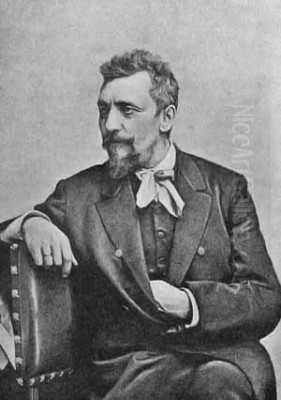
Carl Heinrich Bloch stands as a monumental figure in Danish art history, particularly revered for his poignant and powerful depictions of biblical narratives. While his name might not resonate as globally as some of his European contemporaries, his impact on religious art, especially within Denmark and among certain Christian denominations worldwide, is undeniable. His life, spanning a dynamic period of artistic evolution in Europe, was dedicated to a vision that fused academic precision with profound spiritual depth, leaving behind a legacy that continues to inspire and provoke contemplation.
Early Life and Nascent Passion
Born on May 23, 1834, in Copenhagen, Denmark, Carl Heinrich Bloch entered a world where the echoes of the Danish Golden Age of art were still palpable. His parents, Jørgen Peter Bloch, a merchant, and Ida Emilie Ulrikke Henriette Weitzmann, envisioned a more conventional and secure career for their son, specifically that of an officer in the Royal Danish Navy. However, the young Bloch harbored a different calling, one that pulled him irresistibly towards the realm of art. From an early age, his passion for drawing and painting was evident, a clear indication of the path he was destined to follow, despite initial familial reservations.
This internal conflict between familial expectation and personal aspiration is a common narrative for many artists, but for Bloch, it was a formative period that likely steeled his resolve. His determination eventually won over his parents, allowing him to formally pursue his artistic education. This decision set him on a course that would not only define his own life but also contribute significantly to the artistic heritage of his nation.
Academic Foundations and Formative Influences
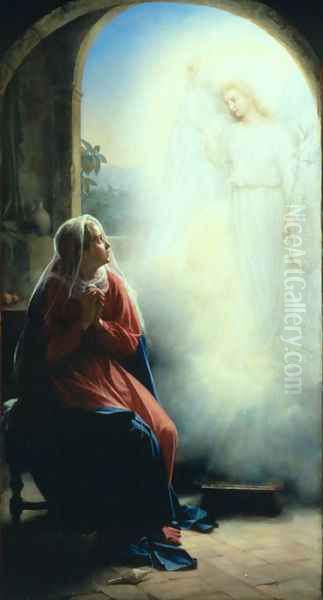
At the age of fifteen, in 1849, Carl Bloch enrolled at the prestigious Royal Danish Academy of Fine Arts (Det Kongelige Danske Kunstakademi) in Copenhagen. This institution, founded by King Frederik V in 1754, had been the crucible for the Danish Golden Age, nurturing talents like Christoffer Wilhelm Eckersberg, considered the father of the period, and his students, including Christen Købke, Martinus Rørbye, and Wilhelm Bendz. While Bloch entered the Academy as this era was waning, its emphasis on meticulous observation, classical composition, and technical skill undoubtedly shaped his foundational training.
During his academic years, Bloch studied under Wilhelm Marstrand (1810-1873), a prominent professor at the Academy and a significant figure in Danish art himself. Marstrand was known for his historical paintings, genre scenes, and portraits, and his tutelage would have provided Bloch with a strong grounding in academic principles. However, Bloch's artistic gaze was also drawn to the works of the Old Masters. He developed a profound admiration for the Dutch master Rembrandt van Rijn (1606-1669). Rembrandt's dramatic use of chiaroscuro, his ability to convey deep human emotion, and his psychological insight into his subjects, particularly in biblical scenes, resonated deeply with Bloch and would become a lasting influence on his own artistic style.
The Grand Tour: Italy and the Broadening of Horizons
A pivotal moment in Bloch's development came in 1859 when he received a travel stipend from the Academy. Such grants were crucial for aspiring artists, enabling them to experience firsthand the masterpieces of European art. Accompanied by his close friend and fellow artist, Anton Dorph (1831-1914), Bloch embarked on a journey that took him through the Netherlands, where he could study Rembrandt's works more closely, and France, before settling in Italy for several years, primarily in Rome, from 1859 to 1866.
Italy, with its rich classical heritage and the legacy of Renaissance and Baroque masters, was a transformative environment. Here, Bloch immersed himself in the art of Michelangelo, Raphael, Titian, and Caravaggio. The grandeur of their religious compositions, the dynamism of their figures, and the emotional intensity of their narratives undoubtedly expanded his artistic vocabulary and ambition. It was in Italy that Bloch truly honed his skills and began to define his artistic identity, moving from genre scenes of Italian life to more ambitious historical and religious subjects. His painting In a Roman Osteria (1866), which depicts a lively scene in a Roman tavern, is a celebrated work from this period, showcasing his keen observation and ability to capture character and atmosphere. This painting was actually a friendly competition with Marstrand and the French academic painter Jean-Léon Gérôme, who painted similar subjects.
Rise to Prominence: The Call of Religious Art
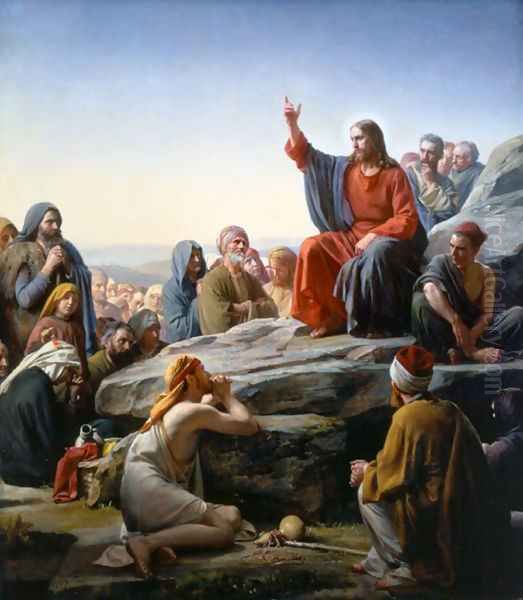
Upon his return to Denmark, Bloch's reputation began to grow. While he continued to produce genre paintings and portraits, his primary focus increasingly shifted towards religious themes. This was a period when large-scale public commissions, particularly for churches and national institutions, were significant markers of an artist's success. Bloch's deep personal faith, combined with his academic training and the profound influence of the Old Masters, made him exceptionally suited for such undertakings.
His ability to render biblical scenes with both historical verisimilitude and emotional resonance appealed to the sensibilities of the time. He was not merely illustrating scripture; he was interpreting it, imbuing his figures with a sense of humanity and spiritual gravitas that invited viewers to connect with the sacred narratives on a personal level. This approach distinguished him and set the stage for his most significant commission.
The Frederiksborg Chapel Commission: A Monumental Undertaking
The crowning achievement of Carl Bloch's career was undoubtedly the commission to create a series of 23 paintings depicting scenes from the life of Christ for the King's Oratory (prayer chapel) in Frederiksborg Palace. The original palace had suffered a devastating fire in 1859, and its restoration, led by the brewer J.C. Jacobsen (founder of Carlsberg), was a national project. Jacobsen, a great patron of the arts, personally selected Bloch for this monumental task.
From 1865 to 1879, over a period of fourteen years, Bloch dedicated himself to this immense project. The series begins with The Annunciation and culminates with The Ascension, covering key moments in Christ's ministry, passion, and resurrection. Each painting is a testament to Bloch's mastery of composition, his understanding of human anatomy and expression, and his skillful use of light and shadow to create dramatic effect. Works like The Sermon on the Mount, Christ Healing the Sick at Bethesda, The Last Supper, and The Resurrection from this series are particularly renowned.
These paintings, still in situ at Frederiksborg Castle (now the Museum of National History), became immensely popular and were widely reproduced, not only in Denmark but internationally. They solidified Bloch's reputation as one of Scandinavia's foremost religious painters. The emotional intensity and narrative clarity of these works made them accessible and moving to a broad audience.
Other Notable Religious Works and Altarpieces
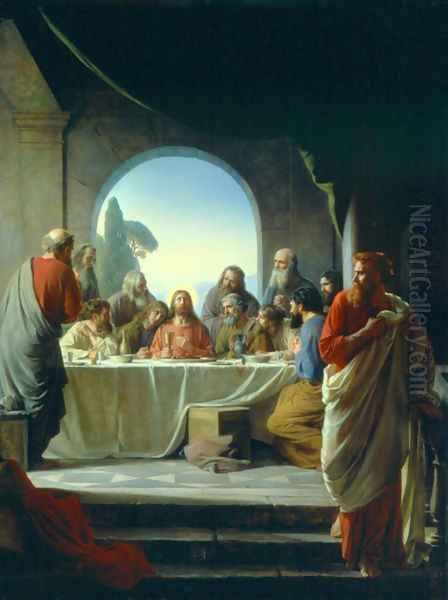
Beyond the Frederiksborg series, Bloch created numerous other significant religious paintings and altarpieces for churches throughout Denmark and even in neighboring Sweden. Notable examples include The Doubting Thomas (1881), a powerful portrayal of the apostle's encounter with the risen Christ, and The Transfiguration. His altarpieces can be found in churches in Holbæk, Odense, Ugerløse, and Copenhagen in Denmark, as well as in Löderup, Hörby, and Landskrona in Sweden.
Each of these works demonstrates Bloch's consistent ability to convey the spiritual significance of the biblical narrative while grounding it in a tangible, human reality. His figures are often robust and expressive, their gestures and facial expressions conveying a wide range of emotions, from awe and reverence to sorrow and doubt. This humanizing approach, combined with a sense of divine presence, is a hallmark of his religious art.
Genre Paintings and Portraits: A Broader Scope
While religious art formed the core of his oeuvre, Carl Bloch was also an accomplished painter of genre scenes and portraits. His early works, particularly those from his time in Italy, such as In a Roman Osteria, demonstrate a lively interest in everyday life and a talent for capturing local color and character. These paintings often possess a warmth and humor that contrasts with the solemnity of his religious subjects.
He also painted historical scenes, such as Christian II in Prison at Sønderborg (1871), which showcases his ability to handle complex historical narratives with dramatic flair. His portraits, though less numerous than his religious or genre works, reveal a keen psychological insight and a solid technical command. These works demonstrate the breadth of his talent and his engagement with the various artistic currents of his time, even as he remained primarily committed to his religious calling. He was a contemporary of the Skagen Painters like P.S. Krøyer and Michael Ancher, who were exploring different facets of realism and plein-air painting, but Bloch largely maintained his academic and studio-based approach, particularly for his large-scale commissions.
Artistic Style and Technique: A Synthesis of Traditions
Carl Bloch's artistic style is characterized by a synthesis of academic precision, a deep reverence for the Old Masters (especially Rembrandt), and a distinctly Northern European sensibility. His compositions are typically well-ordered and balanced, adhering to classical principles, yet they are often infused with a dynamic energy and emotional intensity.
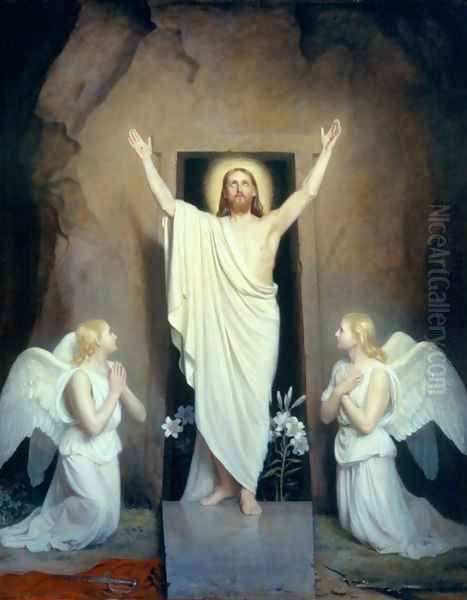
His use of chiaroscuro is particularly noteworthy. Like Rembrandt, Bloch masterfully employed contrasts of light and shadow to model his figures, create a sense of depth, and heighten the dramatic impact of his scenes. Light in his paintings often serves a symbolic function, illuminating key figures or moments and drawing the viewer's eye to the spiritual heart of the narrative.
Bloch's draftsmanship was impeccable, his figures rendered with anatomical accuracy and a strong sense of volume. His brushwork, while generally smooth and controlled in the academic tradition, could also be more expressive when conveying texture or intense emotion. His color palettes are often rich and sonorous, though sometimes subdued to enhance the solemnity of the subject matter. He shared with other great academic painters of his era, such as William-Adolphe Bouguereau in France, a commitment to technical excellence and narrative clarity, though Bloch's focus remained more consistently on religious themes than on the mythological or allegorical subjects favored by some of his French counterparts.
Personal Life: Dedication and Loss
Carl Bloch married Alma Trepka in 1868. Their union appears to have been a happy one, but it was marked by tragedy when Alma passed away prematurely in January 1886. This loss was a profound blow to Bloch. Friends and acquaintances noted a change in his demeanor, a deepening of his already somewhat reserved nature. Despite this personal sorrow, he continued to work, finding solace and purpose in his art.
Bloch was known to be a man of deep faith, and this personal conviction undoubtedly fueled his artistic endeavors, particularly his religious paintings. He was described as diligent, serious-minded, and perhaps not always adept at forming very close, effusive friendships, though he maintained cordial relationships with many in the artistic and literary circles of Copenhagen. Among these was the famed author Hans Christian Andersen (1805-1875). While their interactions are documented, including Bloch creating a drawing for Andersen that Andersen humorously described as a "bad enough Annunciation," their relationship seems to have been one of mutual respect rather than deep intimacy, perhaps reflecting Bloch's more introverted personality.
Relationships with Contemporaries

Bloch's career unfolded during a vibrant period in Danish art. He was a contemporary of figures like Anton Dorph, his travel companion and lifelong friend. He also knew literary figures such as the writer Frederik Bøgh. The artistic landscape of Denmark was evolving, with younger artists like Theodor Philipsen exploring Impressionism, and the Skagen Painters, including Anna and Michael Ancher and P.S. Krøyer, gaining prominence with their plein-air depictions of fisherfolk and coastal life.
While Bloch's style remained rooted in academic tradition and historical painting, he was certainly aware of these newer trends. However, his primary commitment was to his large-scale religious and historical works, which required a different approach and methodology. His dedication to these genres set him somewhat apart from the avant-garde movements of his later years, but it also secured his unique place in Danish art history.
Later Years, Death, and Initial Legacy
Carl Heinrich Bloch continued to paint and fulfill commissions until his death from stomach cancer on February 22, 1890, in Copenhagen, at the relatively young age of 55. He was buried in the Assistens Cemetery, a resting place for many of Denmark's most notable figures.
In the immediate aftermath of his death and into the early 20th century, as Modernism began to dominate the art world, Bloch's work, like that of many academic painters, experienced a period of relative neglect within mainstream art historical discourse. The emphasis shifted towards innovation, abstraction, and a rejection of traditional narrative painting. Bloch's meticulous realism and his focus on religious themes were seen by some as old-fashioned or overly sentimental.
Re-evaluation and Enduring Influence
Despite this temporary eclipse, Carl Bloch's art never truly faded from public consciousness, especially in Denmark. The Frederiksborg Palace paintings remained a major attraction, and reproductions of his work continued to be popular, particularly within religious communities.
In more recent decades, there has been a significant re-evaluation of 19th-century academic art, and Carl Bloch's contributions have received renewed appreciation. Art historians now recognize the technical brilliance, emotional power, and cultural significance of his work. His ability to translate complex theological concepts into accessible and moving visual narratives is particularly admired.

A significant factor in Bloch's enduring international influence has been the adoption of his imagery by The Church of Jesus Christ of Latter-day Saints (LDS Church). Reproductions of his paintings, especially those from the Frederiksborg series, are widely used in LDS meetinghouses, temples, publications, and educational materials worldwide. This has introduced Bloch's art to millions who might otherwise never have encountered it, giving his depictions of Christ's life a global reach. The BYU Museum of Art in Provo, Utah, holds a significant collection of his altarpieces and other works, further cementing this connection.
Collections and Public Access
Today, Carl Heinrich Bloch's most important works are accessible to the public in several key locations. The primary collection is, of course, the series of 23 paintings in the chapel of Frederiksborg Castle, Hillerød, Denmark. The Statens Museum for Kunst (National Gallery of Denmark) in Copenhagen also holds important works by Bloch. As mentioned, the BYU Museum of Art in Provo, Utah, USA, has a notable collection, including several large altarpieces acquired from Danish churches. Various other churches in Denmark and Sweden still house his altarpieces, allowing them to be seen in their original liturgical contexts.
Conclusion: A Master of Sacred Storytelling
Carl Heinrich Bloch was more than just a skilled academic painter; he was a profound visual theologian, a storyteller in paint who brought the narratives of the Christian faith to life with unparalleled passion and precision. His dedication to his craft, his deep personal faith, and his ability to connect with the emotional and spiritual core of his subjects ensured that his work transcended the stylistic trends of his time. While he may have been overshadowed for a period by the rise of modern art, his legacy endures, not only as a key figure in Danish art history but also as an artist whose depictions of Christ's life continue to inspire faith and devotion in countless individuals around the world. His art serves as a powerful reminder of the enduring capacity of figurative painting to convey profound human and divine truths.